According to Hindu mythology, moonstone is made of moonbeams! And it’s easy to see why so many cultures also associate the gem with moonlight. Read on to learn all about this remarkable gem, including what gives moonstone its other-worldly glow.

Shimmering moonlight and twinkling stars, these platinum earrings feature moonstones, diamonds and Montana sapphires. Designed by GIA graduate Loretta Castoro, GG. Photo: Kevin Schumacher/GIA.
Moonstone’s internal structure scatters light, creating a visual phenomenon known as adularescence – a light that appears to move across the gemstone, giving its surface a glowing appearance. The misty light rolls across the gem as you move it, reminding us of the full moon shining through a veil of thin, high clouds.
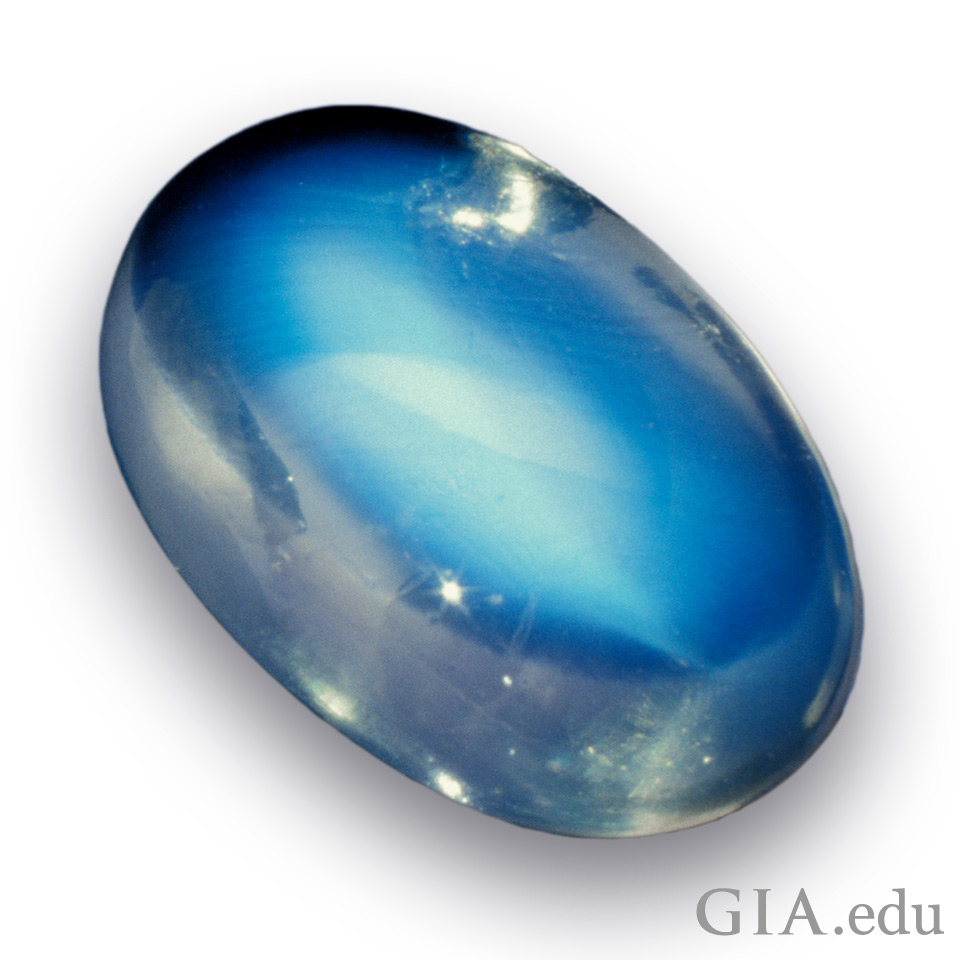
A moonstone from the feldspar-group mineral orthoclase shimmers and glows an electric blue. Photo: Robert Weldon/GIA. Courtesy: D. Humphrey
What is Moonstone?
Moonstone is gem-quality feldspar – a group of closely related mineral species – the most widespread minerals in the earth’s crust as well as some of the most diverse. Moonstone can be not one, but two feldspar species, orthoclase and albite. Other feldspar minerals that may also show adularescence are labradorite and sanidine (another variety of orthoclase). To be called moonstone, a mineral’s actual chemical composition is not as important as the beauty of its adularescence.
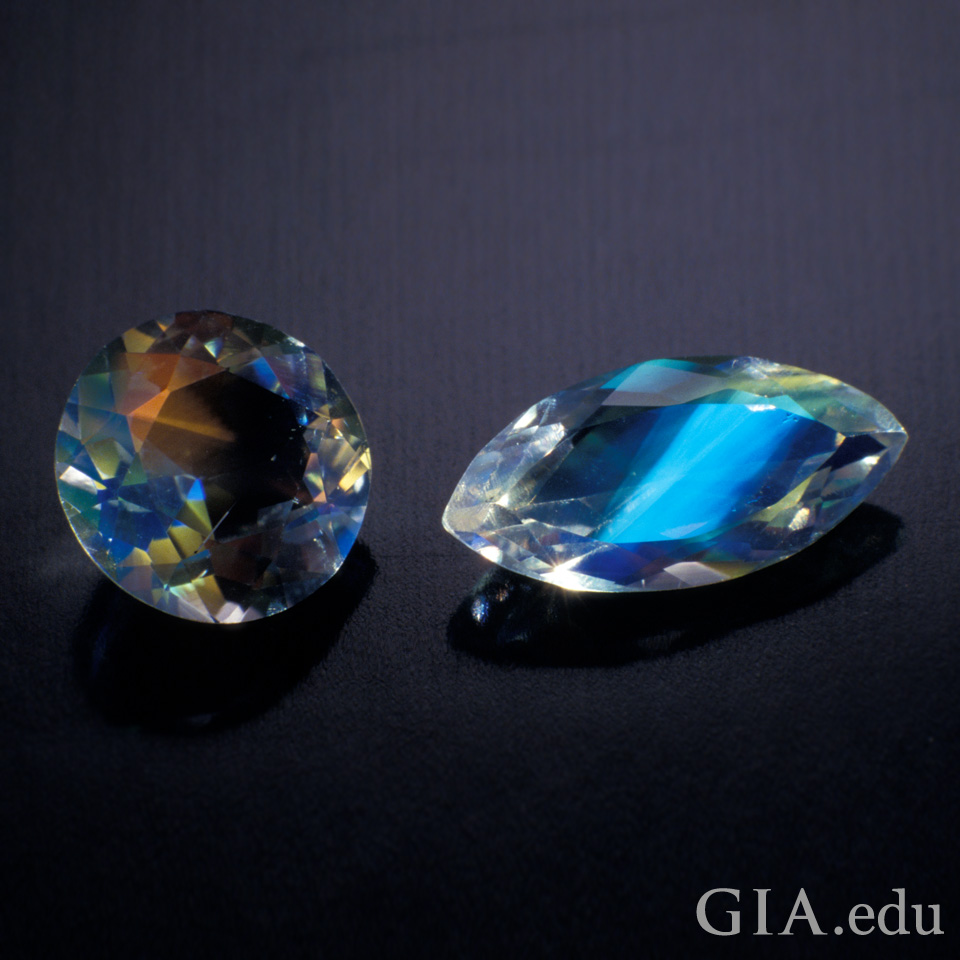
The feldspar mineral labradorite—found in Madagascar—has a multicolored adularescence over a light bodycolor. It’s known in the trade as rainbow moonstone, shown here as faceted gems. Photo: Robert Weldon/GIA
Buying Moonstones: What to Look For
Color
The most highly favored moonstones have a colorless, semitransparent to nearly transparent appearance without visible inclusions, and a vivid blue adularescence, known in the trade as blue sheen. The finest moonstone is a gem of glassy purity with a mobile, electric blue shimmer.
Moonstone colors can vary widely: they can be white, green, yellow to brown, or gray to nearly black. In addition to blue, the adularescent effect can also be silver or white.
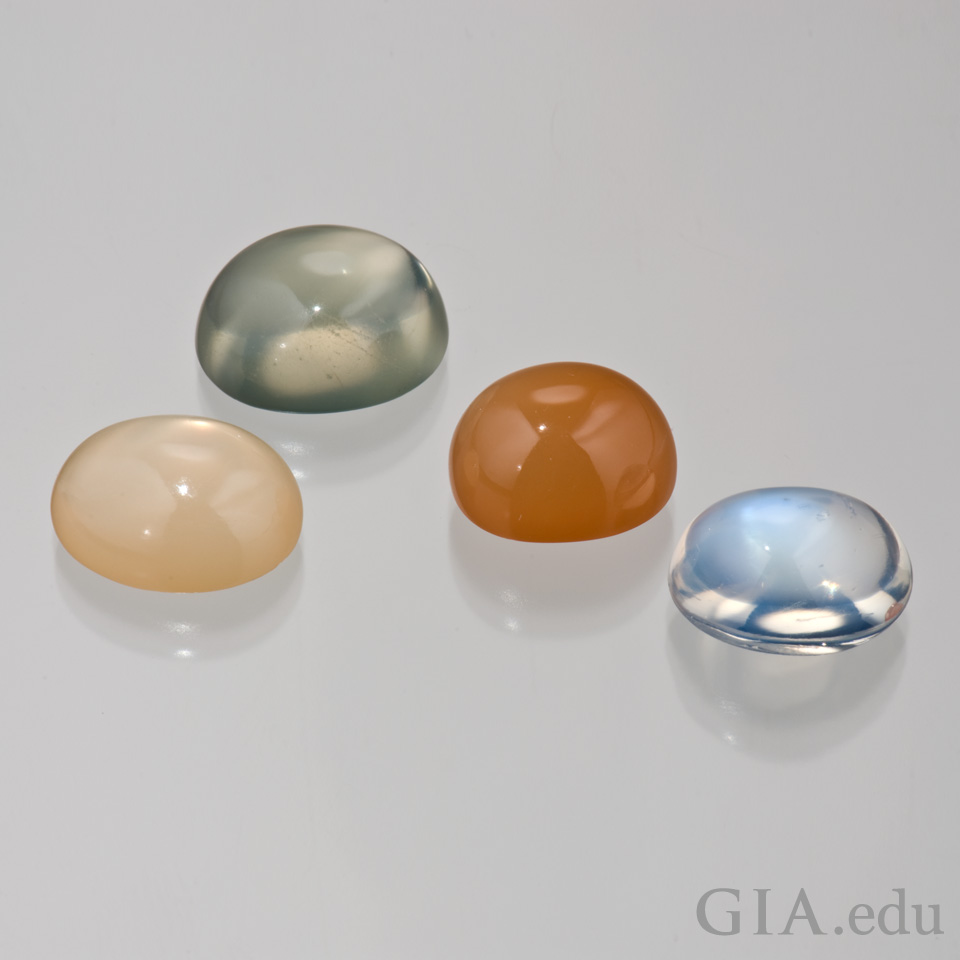
Moonstone feldspar offers an array of colors: (left to right) an 8.28 ct light orange moonstone, a 15.24 ct gray moonstone and a 10.55 ct orange moonstone all from India; and 8.74 light blue moonstone from Sri Lanka. Photo: Robert Weldon/GIA.

Inclusions called “centipedes” are typical of moonstone. They resemble the long, thin creatures with many legs. Photo: Dr. E. J. Gübelin/GIA
Clarity
A good moonstone should be as free of inclusions as possible, since visible inclusions can potentially interfere with adularescence.
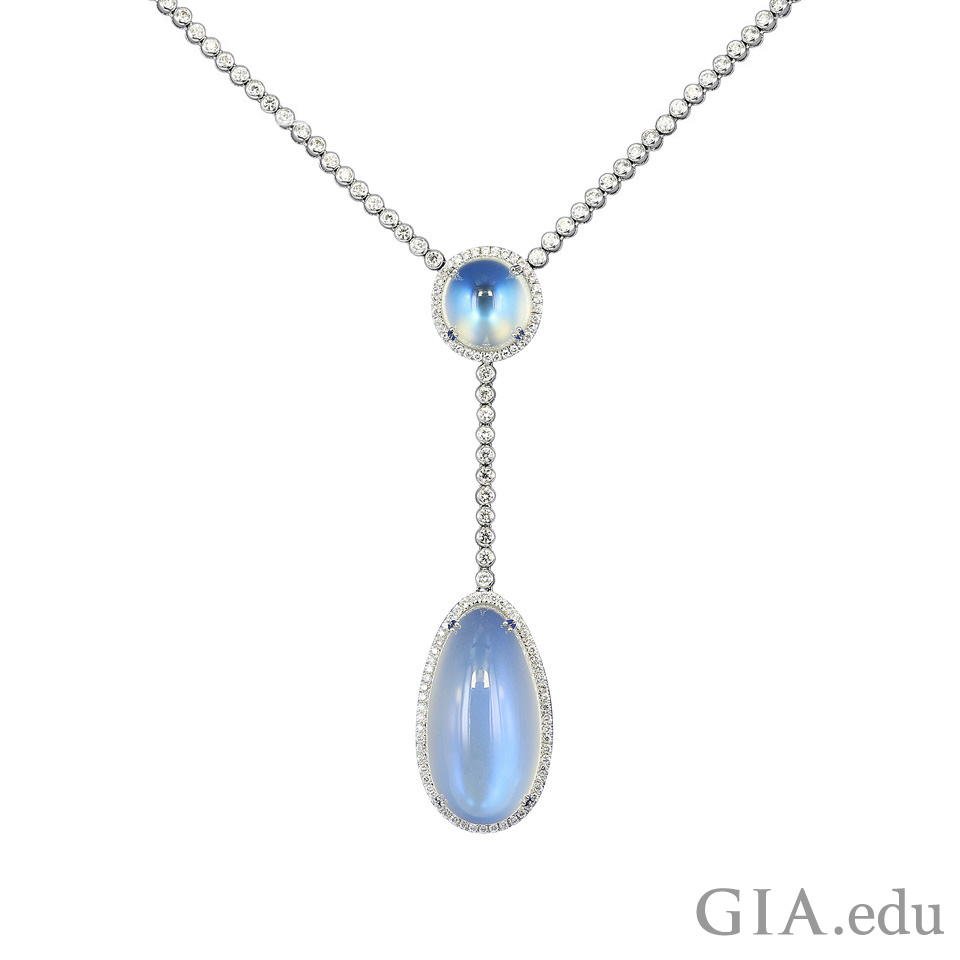
Set in 18K gold, this pendant features a pear shape moonstone cabochon weighing 77.93 ct and a round cabochon weighing 16.66 ct, both encircled by 214 round brilliant cut diamonds with a total weight of 7.48 carats. Courtesy: 1stdibs.com
Cut
Moonstone might be fashioned into beads for strands, but the most common cutting style is the cabochon, a form that displays its phenomenal color, or colors, to the best advantage. Cabochon dimensions should be uniform and the profile shouldn’t be too flat, so as to emphasize moonstone’s signature sheen.

A smiling moon is carved into a 10 mm moonstone and bezel set in 18K gold, accented by a star with melee diamonds. Copyright: GIA & Tino Hammid. Courtesy: 23rd St. Shoppe, Santa Monica, California
Moonstone is popular for carving into decorative jewelry elements, such as cameos or the popular “man-in-the-moon” face that plays on the gem’s name. The uneven surface of the carving combines with the shifting adularescent sheen to create a delightfully intricate and lively effect.
Carat Weight
Moonstone comes in a wide range of sizes and carat weights. However large, fine quality moonstone is unusual.

Moonstones from Tanzania displaying adularescence and chatoyancy: the cat’s eye effect. The large stone weighs 20.18 ct and the small stones weigh (left to right) 7.84 ct, 8.78 ct and 3.54 ct. Photo: Robert Weldon/GIA
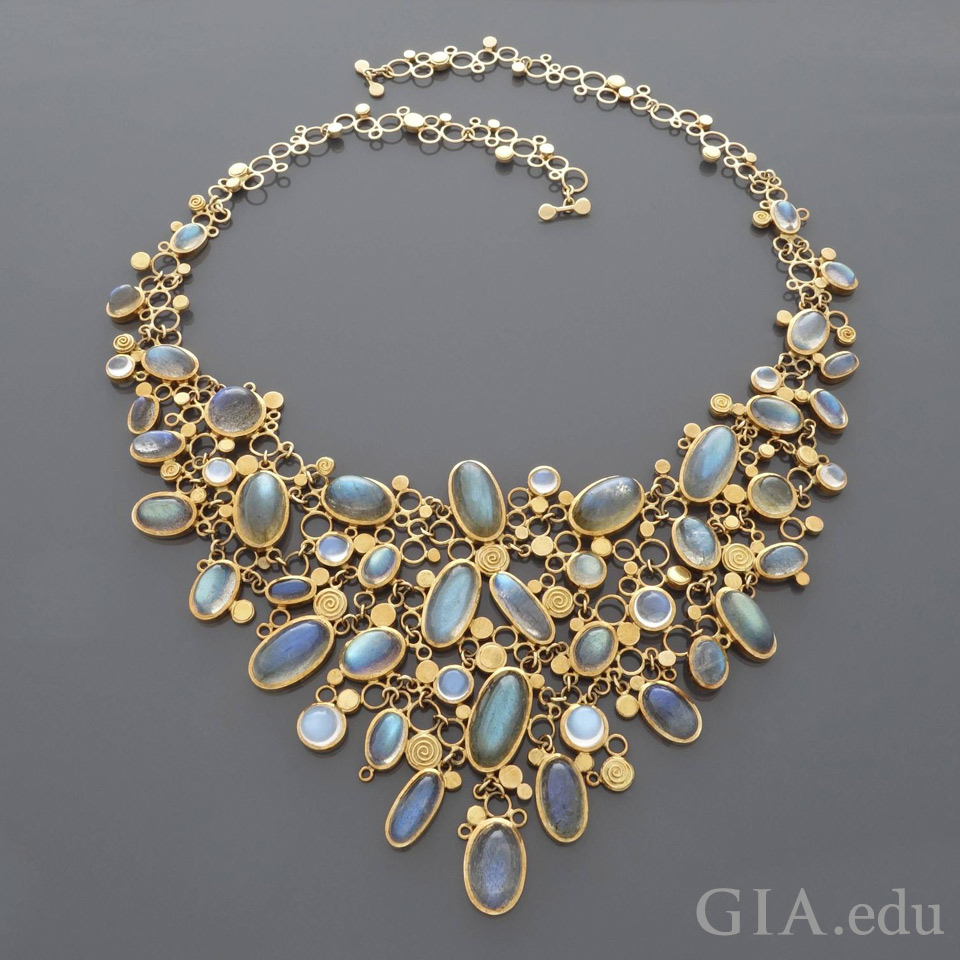
A vintage 18K gold necklace from the 1960s by German jewelry designer Kathe Ruckenbrod highlights the varying colors and sheens of labradorite moonstones. Courtesy: 1stdibs.com
Moonstone Care
Moonstone ranks 6.0 to 6.5 on the Mohs Hardness Scale and has poor toughness, so it is less durable than sapphire, diamond, or amethyst. It is vulnerable to scratching and also chipping or cleaving if accidentally hit against a hard surface. That’s why you’ll usually find moonstone set into pendants, earrings, and brooches. Moonstone is not typically treated, and cleaning with warm soapy water is always safe. Avoid ultrasonic or steam cleaners.
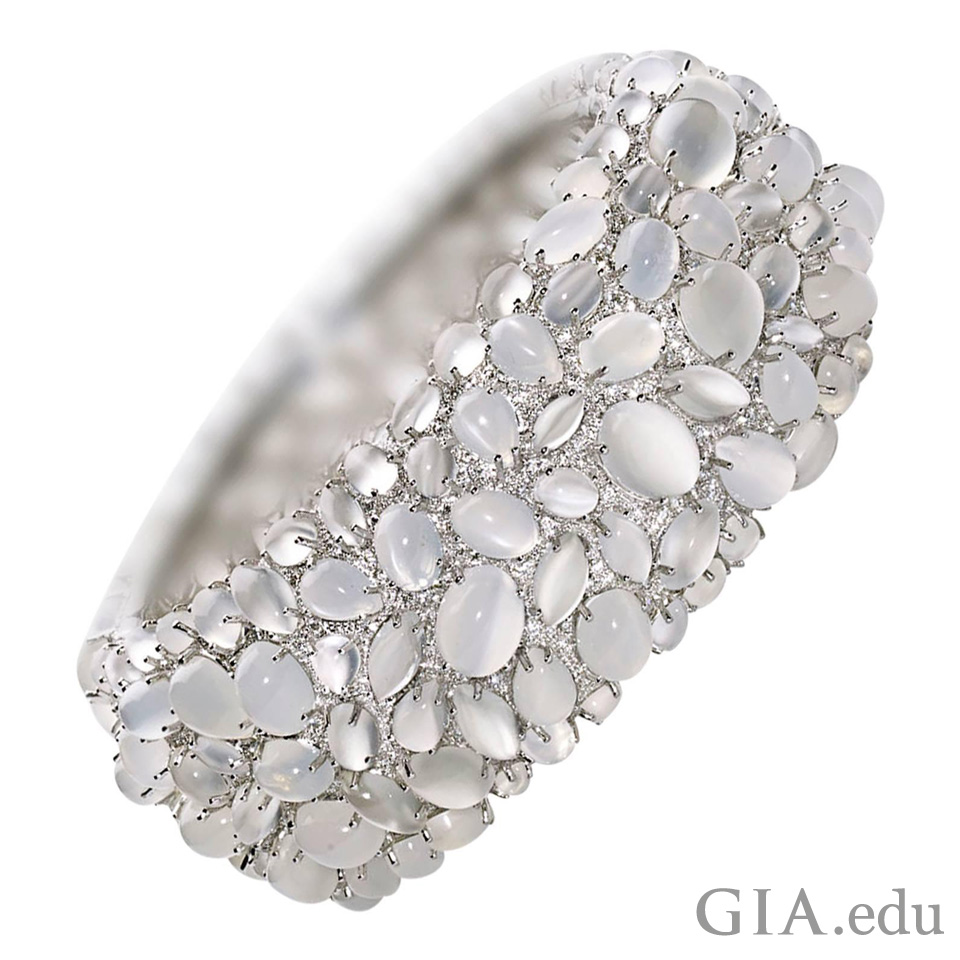
Moonstone is not a tough gem, so you will want to reserve this beautiful bangle for special moonlight occasions: cabochon cut moonstones and pavé set round brilliant cut diamonds, mounted in 18K white gold. Courtesy: 1stdibs.com
Legends say that moonstone brings good luck. And many believed that you could see the future if you held a moonstone in your mouth during a full moon. So as you gaze upon the moon and wonder what tomorrow has in store, consider acquiring a moonstone. It may not foretell the future, but you’ll carry a little bit of moonlight wherever you go.
Learn more about moonstone and check out our Moonstone Buying Guide!
